Confined formation of monoclinic Na4Ti5O12 nanoparticles embedded into porous CNTs: towards enhanced electrochemical performances for sodium ion batteries†
Abstract
Monoclinic Na4Ti5O12 (M-Na4Ti5O12) has continuous two-dimensional (2D) channels with Na sites that are partially occupied, providing a broad pathway and sufficient space for the intercalation of Na+. However, the capacity of M-Na4Ti5O12 does not meet the requirement of an anode material for practical applications, due to its poor Na+ diffusion kinetics. Herein, by utilizing the unique advantages of hybrid nanostructures, we overcome these impediments by fabricating M-Na4Ti5O12/C hybrid porous nanotubes. Bamboo-like porous CNTs homogeneously embedded with M-Na4Ti5O12 nanoparticles were derived from bamboo-like polymer nanotubes, which acted as the source of carbon and the template to shape the M-Na4Ti5O12 nanoparticles without the presence of aggregation. The hybrid structure not only provided a conductive and interconnected carbon matrix, but also accommodated the volume change during electrochemical reaction processes. As a result, the hybrid showed excellent rate performance and cycling stability as an anode for sodium ion batteries (SIBs), with a capacity retention of 44.2 mA h g−1 after 3000 cycles at 1 A g−1. Such a new hybrid structure should be a promising candidate as an anode material for SIBs.



 Please wait while we load your content...
Please wait while we load your content...